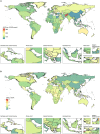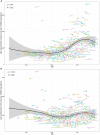The global burden of traumatic amputation in 204 countries and territories
- PMID: 37927851
- PMCID: PMC10622756
- DOI: 10.3389/fpubh.2023.1258853
The global burden of traumatic amputation in 204 countries and territories
Abstract
Background: Traumatic amputation leads to disability and imposes a heavy health burden. This study aims to explore the current status and temporal trends of the global burden of traumatic amputation according to sex, age, amputation site, cause, and reginal level of social development.
Methods: The data were extracted from the Global Burden of Diseases (GBD) Study 2019. Prevalence, incidence, years lived with disability (YLDs) and corresponding age-standardized rate were compared. Estimated annual percentage change (EAPC) was applied to reflect trends in age-standardized rates over a specific period. Spearman rank test and curve fitting methods were used to analyze the relationship between disease burden and Socio-Demographic Index (SDI).
Results: Globally, the incidence and prevalence number of traumatic amputation increased from 11.37 million and 370.25 million in 1990, to 13.23 million and 552.45 million in 2019, with a raise of 16.4 and 49.2%, respectively. But the age-standardized incidence rate (ASIR) (EAPC = -0.56; 95%CI, -0.72 to -0.41) and age-standardize prevalence rate (ASPR) (EAPC = -0.63; 95%CI, -0.74 to -0.52) declined during this period. The YLDs count also increased by 39.2% globally (from 5.28 million to 7.35 million), while the age-standardize YLDs rate (ASYR) decreased by an average of 1.00% per year (95% CI, -1.10 to -0.90) from 1990 to 2019. The incidence, prevalence, and YLDs rate of traumatic amputation continue to increase with age. Traumatic amputations were most common in the fingers, while unilateral lower limb amputation caused the greatest burden of disability. ASIR and SDI were positively correlated (ρ = 0.442, p < 0.001), while ASYR and SDI were not significantly correlated (ρ = -0.030, p = 0.669), and EAPC in ASYR and SDI were negatively correlated (ρ = -0.275, p < 0.001). Exposure to mechanical forces and falls were the leading causes of traumatic amputation.
Conclusion: Despite the declining trends in ASIR, ASPR, and ASYR, the incidence, prevalence, and YLDs counts of traumatic amputation have increased significantly worldwide, especially in the older adults population. With the population aging, targeted health policies are needed to address the increasing global burden of traumatic amputations in the future.
Keywords: amputation; disability study; global burden of disease; incidence; years lived with disability.
Copyright © 2023 Yuan, Hu, Gu, Xiao and Song.
Conflict of interest statement
The authors declare that the research was conducted in the absence of any commercial or financial relationships that could be construed as a potential conflict of interest.
Figures






References
-
- Ahmad N, Thomas GN, Gill P, Chan C, Torella F. Lower limb amputation in England: prevalence, regional variation and relationship with revascularisation, deprivation and risk factors. A retrospective review of hospital data. J R Soc Med. (2014) 107:483–9. doi: 10.1177/0141076814557301, PMID: - DOI - PMC - PubMed
-
- López-López L, Losa-Iglesias ME, Gómez-Salgado J, Becerro-de-Bengoa-Vallejo R, Romero-Morales C, López-López D, et al. . The implications of diabetic foot health-related with quality of life: A retrospective case control investigation. J Tissue Viability. (2022) 31:790–3. doi: 10.1016/j.jtv.2022.07.003, PMID: - DOI - PubMed
MeSH terms
LinkOut - more resources
Full Text Sources

